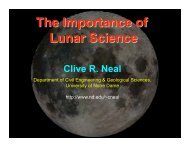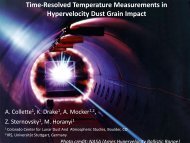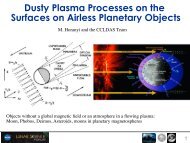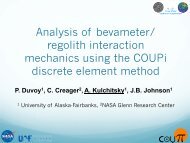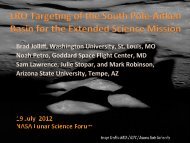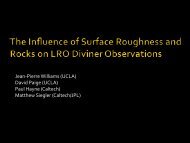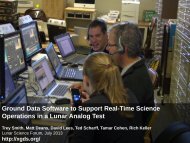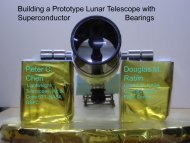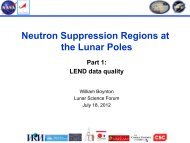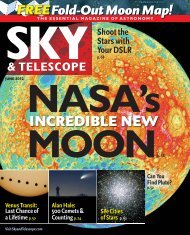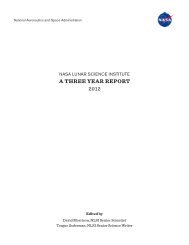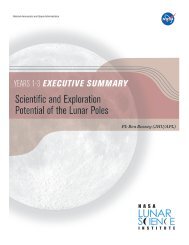- Page 1 and 2: NASA Conference Publication 3343Fro
- Page 3 and 4: PREFACEOn June 24 through 26, 1996,
- Page 5 and 6: TABLE OF CONTENTSPreface...........
- Page 7 and 8: The role of hydrogen in small amorp
- Page 9: P PIC AND SIMILAR DISK-LIKE OBJECTS
- Page 12 and 13: y linear deconvolution of the SSA i
- Page 14 and 15: `planetesimals'. Those ones are spa
- Page 18 and 19: Table 1 Best-fitting model paramete
- Page 20 and 21: 10-10SAO 179815 (HD 98800)10-1110-1
- Page 22 and 23: 2. 0 Pic-like SYSTEMSOne of the gre
- Page 24 and 25: Backman, D. E., and Paresce, F. 199
- Page 27 and 28: PARTIALLY CRYSTALLINE SILICATE DUST
- Page 29 and 30: 12D 100546 vs Forsterite (dashed) a
- Page 31 and 32: HIGH RESOLUTION SPECTROSCOPY OF VEG
- Page 33 and 34: accretion hypothesis, King (1994) i
- Page 35 and 36: TRANSIENT ACCRETION EVENTS IN HERBI
- Page 37 and 38: e ionized by the stellar radiation
- Page 39: STAR FORMATION31
- Page 42 and 43: 1980 1985 1990 19959.09.5®rIL10.01
- Page 44 and 45: 4. DISCUSSION AND CONCLUSIONSWe hav
- Page 46 and 47: 2. SHELL MODELThe dusty envelope is
- Page 48 and 49: — "Fluffiness" of dust particles.
- Page 50 and 51: 2. OBSERVATIONSThe observations wer
- Page 52 and 53: 1050.015^ ^o.,a •,o a0s0au0—5
- Page 54 and 55: IMAGING POLARIZED DUST EMISSION IN
- Page 56 and 57: Figure 3. The total intensity (left
- Page 58 and 59: 0fvac = 0.3(dot), 0.5(dash), 0.7(li
- Page 60 and 61: lo`lo'00axto-,00a10 -20lo-''10' to
- Page 63 and 64: EXTERNALLY INDUCED EVAPORATION OF Y
- Page 65 and 66: 0-6—7—8—9v -10OD0Dispersal Ra
- Page 67:
CIRCUMSTELLAR DUST59
- Page 70 and 71:
Table 1 SiC features and the Temper
- Page 72 and 73:
have very similar absorption featur
- Page 74 and 75:
mSE1 .-SE3 -SE4U NA iLtSE5 --SE6 SE
- Page 76 and 77:
3. CARBON STARSSloan, Little-Mareni
- Page 78 and 79:
eferences therein). The arc dischar
- Page 80 and 81:
the time scale of their evolution:
- Page 82 and 83:
easily amended for any chemical spe
- Page 84 and 85:
25002000a^a^H150010001 2 3 4r/Rstar
- Page 86 and 87:
2. METHODThe stellar wind model is
- Page 88 and 89:
0 0.04(a)3007EU200(b)0.03Ec 0.02^s0
- Page 90 and 91:
0 CETIX = 8-9 µm ,(off dust featur
- Page 92 and 93:
Examining a number of grain types,
- Page 95 and 96:
REVISED DEPLETIONS AND NEW CONSTRAI
- Page 97 and 98:
- 1 -Table 1.__Revised stellar and
- Page 99:
ReferencesAannestad, P. 1995, ApJ,
- Page 102 and 103:
3.02.52.0CL1.51.00.50.03 4 5 61 /X
- Page 104 and 105:
ReferencesAnderson, C.M. et al. 199
- Page 106 and 107:
2.1. ExtinctionInfrared photometry
- Page 109 and 110:
THE EXTINCTION PROPERTIES OFHEAVILY
- Page 111 and 112:
3. ANALYSISUsing a Quantimet Q520 i
- Page 113 and 114:
HAC: BAND GAP, PHOTOLUMINESCENCE, A
- Page 115 and 116:
3.2. The 3.4 micron Absorption Band
- Page 117 and 118:
THE ROLE OF HYDROGEN IN SMALL AMORP
- Page 119 and 120:
R 100an'c30w 0 Wa.AE-50A 1C.q-t0.5x
- Page 121 and 122:
OBSERVATIONS OF TWO NON-STANDARD GR
- Page 123 and 124:
where VSGs break off larger grains
- Page 125 and 126:
IRAS COLORS OF THE PLEIADESSEAN J.
- Page 127 and 128:
4. IDENTIFICATION OF DENSE (MOLECUL
- Page 129 and 130:
PAH EMISSION IN THE ORION BARJESSE
- Page 131 and 132:
0.80.60.40.20.8N 0.60.4DN 0.2^ E b:
- Page 133 and 134:
LABORATORY EXPERIMENTS ON THE REACT
- Page 135 and 136:
500Cto 8+ + 0 ®> CgH8+ + CO400AvrA
- Page 137 and 138:
433v02110 30 60 90 120 150 180 210F
- Page 139 and 140:
PROCESSING OF ICY MANTLES IN PROTOS
- Page 141 and 142:
tions of mixtures each provide exce
- Page 143 and 144:
THE ICE AND SILICATE SPECTRAL FEATU
- Page 145 and 146:
2.5Model C (a= 1µm)—f=0.2-'1 - -
- Page 147 and 148:
EVIDENCE FOR THE EVOLUTION OF GRAIN
- Page 149 and 150:
(a) Ih2FIRS,_I(h}p 56^LOo . o FIR4'
- Page 151 and 152:
THE ABUNDANCES OF CHARGED PARTICLES
- Page 153 and 154:
2.3. Grain Charge TransferIn order
- Page 155 and 156:
THE PROTOSOLAR NEBULA147
- Page 157 and 158:
CATALYSIS BY DUST GRAINS IN THE SOL
- Page 159 and 160:
Figure 1 shows the steps involved i
- Page 161 and 162:
(e.g., surface-catalyzed) ones. Thi
- Page 163 and 164:
RESTRUCTURING OF DUST AGGREGATES IN
- Page 165 and 166:
3. AN EXAMPLE CALCULATIONWe have in
- Page 167 and 168:
EFFECT OF DUST COAGULATION DYNAMICS
- Page 169 and 170:
NUMERICAL SIMULATIONS FOR SUM KERNE
- Page 171 and 172:
SELF-CONSISTENT SIMULATION OF THE B
- Page 173 and 174:
and a diffusivity Di = Tfi kT/mi. D
- Page 175 and 176:
DUST COAGULATION IN PROTOPLANETARYA
- Page 177 and 178:
Coogulction tit?- )e• zn /5139,5
- Page 179 and 180:
SIZE SEGREGATION AND NUMBER DENSITY
- Page 181 and 182:
10`1100.01 cm . . . . .0.1 cm . . .
- Page 183 and 184:
FROM CHONDRULES TO PLANETESIMALS:SO
- Page 185 and 186:
Figure 2. Regions of high particle
- Page 187 and 188:
VORTICES AND PLANETESIMALSP. BARGE
- Page 189 and 190:
c0UdWU)0 10 -1ULUiCROSSING * ` yAjr
- Page 191 and 192:
THE ROLE OF VORTICES IN THE FORMATI
- Page 193 and 194:
(a)(b)(c)606060Y40 ,^ Y40 OOY402020
- Page 195 and 196:
THE GLOBAL PERSPECTIVE ON THE EVOLU
- Page 197 and 198:
103102 ..........................10
- Page 199 and 200:
TOWARD AN ASTROPHYSICAL THEORY OFCH
- Page 201 and 202:
and the subsolar temperatureTsub..I
- Page 203 and 204:
PLANETESIMAL FORMATION IN THE OUTER
- Page 205 and 206:
3. SUBLIMATION, CONDENSATION, AND G
- Page 207 and 208:
PLANETESIMALS AND COMETS199
- Page 209 and 210:
THE MASS OF LARGE IMPACTORSM. G. PA
- Page 211 and 212:
99 3JupiterNeptuneA0 20 — 0.00 0.
- Page 213 and 214:
TIDAL BREAKUP OF ASTEROIDS BY THE E
- Page 215 and 216:
Figure 2. Time sequence showing the
- Page 217 and 218:
ON THE DYNAMICS OF THE ZODIACAL DUS
- Page 219 and 220:
de Log U®ro 1 — E2dt aysw Ecos z
- Page 221 and 222:
DUST AND SPUTTERED PARTICLE STREAMS
- Page 223 and 224:
A"P -0.1s^nntU 8 -- -3.2- - 3.6-- 3
- Page 225 and 226:
PRELIMINARY RESULTS OF OBSERVATIONS
- Page 227 and 228:
4. ULYSSES COMET WATCH NETWORKIn 19
- Page 229 and 230:
POROSITY AND PERMEABILITY OF CHONDR
- Page 231 and 232:
from the dessi cation of such a "we
- Page 233 and 234:
5. POROSITY MEASUREMENTS OF BULK CH
- Page 235 and 236:
RAMAN SPECTRUM OF QUENCHEDCARBONACE
- Page 237 and 238:
Raman shift (Acm -1)1000 1300 1600
- Page 239 and 240:
AUTHOR INDEXAdamson, A.J. 101,131 G
- Page 241 and 242:
SUBJECT INDEXabundances, cosmic 89a
- Page 243 and 244:
plasma 216,218polarization 38, 39,
- Page 245 and 246:
OBJECT INDEXAB Aur 20R Cas 15O Ceti
- Page 247 and 248:
ADDRESSES OF PARTICIPANTS239
- Page 249 and 250:
Nancy AgeorgesEmma BakesESONASA Ame
- Page 251 and 252:
Max BernsteinJurgen BlumNASA Ames R
- Page 253 and 254:
Connie ChangSimon ClemettHarvard Un
- Page 255 and 256:
Jamie ElsilaMarina FomenkovaKalamaz
- Page 257 and 258:
Mayo GreenbergUniv. of LeidenHuygen
- Page 259 and 260:
Dan JudnickJohn F. Kerridge5702 Cal
- Page 261 and 262:
John KulanderOliver LayP.O. Box 704
- Page 263 and 264:
Vito MennellaDaffel MoonObservatori
- Page 265 and 266:
Pendleton YvonneSun Hong RhieNASA A
- Page 267 and 268:
Anneila SargentRussell ShipmanCalif
- Page 269 and 270:
Prof. Stanislav SvirschevskyHead of
- Page 271 and 272:
Christoffel WaelkensFrancis P. Wilk
- Page 273:
REPORT DOCUMENTION PAGEForm Approve



